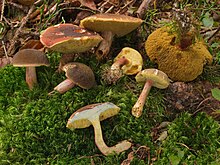
Xerocomus is a genus of poroid fungi related to Boletus. Many mycologists did not originally recognize the distinction between the two genera and placed Xerocomus taxa in genus Boletus. However, several molecular phylogenetic studies have demonstrated that Xerocomus is a heterogeneous genus of polyphyletic origin, which has resulted in further division of Xerocomus into Xerocomellus and Hemileccinum. The members of the genus Xerocomellus are more closely related to Boletus than true Xerocomus is, which is relatively distantly related to Boletus and more closely related to Phylloporus. Other former Xerocomus species have since been moved to Aureoboletus, Imleria, Hortiboletus and Rheubarbariboletus.
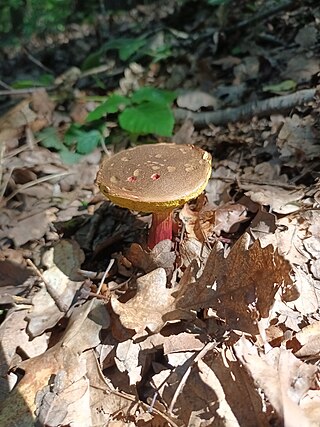
Xerocomellus chrysenteron, formerly known as Boletus chrysenteron or Xerocomus chrysenteron, is a small, edible, wild mushroom in the family Boletaceae. These mushrooms have tubes and pores instead of gills beneath their caps. It is commonly known as the red cracking bolete.

Xerocomus subtomentosus, commonly known as suede bolete, brown and yellow bolete , boring brown bolete or yellow-cracked bolete, is a species of bolete fungus in the family Boletaceae. The fungus was initially described by Carl Linnaeus in 1753 and known for many years as Boletus subtomentosus. It is edible, though not as highly regarded as other bolete mushrooms.
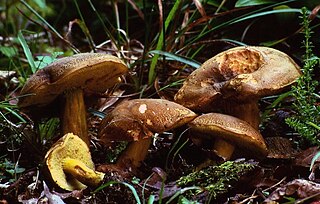
Xerocomellus porosporus is a small wild mushroom in the family Boletaceae. These mushrooms have tubes and pores instead of gills beneath their caps. It is commonly known as the sepia bolete.
Xerocomus silwoodensis is a species of bolete fungus first described in 2007. It was discovered by scientists on Silwood Campus, Imperial College, London and was named after this accordingly. Its discovery on a campus of a leading academic institution has been used to show how little is known about many species. Its discovery was rated as the seventh-best discovery of a new species in 2008 by the International Institute for Species Exploration. It has since been found at two other sites in the United Kingdom and also in France and Italy. It has therefore been asserted that it is a widespread but rare species.

Xerocomellus zelleri, commonly known as Zeller's bolete, is an edible species of mushroom in the family Boletaceae. First described scientifically by American mycologist William Alphonso Murrill in 1912, the species has been juggled by various authors to several genera, including Boletus, Boletellus, and Xerocomus. Found solely in western North America from British Columbia south to Mexico, the fruit bodies are distinguished by their dark reddish brown to nearly black caps with uneven surfaces, the yellow pores on the underside of the caps, and the red-streaked yellow stems. The fungus grows in summer and autumn on the ground, often in Douglas fir forests or on their margins. The development of the fruit bodies is gymnocarpic, meaning that the hymenium appears and develops to maturity in an exposed state, not enclosed by any protective membrane.

Xerocomellus is a genus of fungi in the family Boletaceae. The genus, as it was described in 2008, contained 12 species. However X. rubellus and X. engelii were transferred to the new genus Hortiboletus and X. armeniacus was transferred to the new genus Rheubarbariboletus in 2015. Molecular analysis supports the distinction of Xerocomellus species from Boletus and Xerocomus, within which these species were formerly contained. Xerocomellus in fact is only distantly related to Xerocomus and is most closely related to Tylopilus, Boletus sensu stricto, Porphyrellus, Strobilomyces, and Xanthoconium.

The Boletineae are a suborder of the fungal order Boletales. Families in the Boletineae include the Boletaceae and the Paxillaceae.

Rheubarbariboletus armeniacus is a small mushroom in the family Boletaceae native to Europe. It was formerly placed in the genera Boletus, Xerocomus, and Xerocomellus. It acquired its current name when it was transferred to genus Rheubarbariboletus in 2015.

Hemileccinum is a genus of fungi in the family Boletaceae. It was erected in 2008 by Josef Šutara to contain two species united by a number of shared morphological features: H. depilatum and the type H. impolitum. In 2014, Wu et al. found it to be distinct from other bolete genera in a molecular phylogenetic study and found it to be most closely related to Corneroboletus. In 2015, H. subglabripes was transferred to Hemileccinum from Boletus based on DNA evidence, while subsequent studies further confirmed the monophyly of the genus.
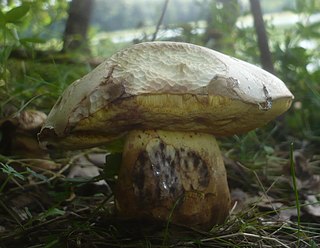
Caloboletus kluzakii is a bolete fungus native to Europe. Until 2014, it was known as Boletus kluzakii. Recent changes in the phylogenetic framework of the family Boletaceae prompted the transfer of this species, along with several other related boletes, including Caloboletus calopus, to the genus Caloboletus. It was described scientifically in 2006 by Josef Šutara and Pavel Špinar, from specimens collected in the Czech Republic. The fungus had earlier been published with the name Boletus fallax by Czech mycologist Zdeněk Kluzák in 1988, but this was invalid, as that name had been used previously by E.J.H. Corner for a Malaysian bolete. The epithet honours Kluzák's contributions in describing the species.

Hemileccinum impolitum is a basidiomycete fungus of the family Boletaceae, native to Europe. It is commonly referred to as the iodine bolete, because its fruit bodies tend to emit an iodine odour when cut, more detectable in the stem base or overripe specimens.

Rheubarbariboletus is a fungal genus in the family Boletaceae. Circumscribed in 2014, it contains two species found in Europe: Rheubarbariboletus persicolor, and the type, R. armeniacus. The generic name is derived from the Latin rheubarbarum, meaning "rhubarb", referring to the color of the flesh at the base of the stipe. The genus is closely related to Xerocomellus, but differs by having smooth spores, the unchanging yellowish to orange-rhubarb coloring of the stipe base, and the distinctive dark-green to black color reaction with iron sulphate on both the surface of the cap and on the flesh of the stipe.

Imleria badia, commonly known as the bay bolete, is an edible, pored mushroom found in Eurasia and North America, where it grows in coniferous or mixed woods on the ground or on decaying tree stumps, sometimes in prolific numbers. Both the common and scientific names refer to the bay- or chestnut-coloured cap, which is almost spherical in young specimens before broadening and flattening out to a diameter up to 15 cm (6 in). On the cap underside are small yellowish pores that turn dull blue-grey when bruised. The smooth, cylindrical stipe, measuring 4–9 cm long by 1–2 cm thick, is coloured like the cap, but paler. Some varieties have been described from eastern North America, differing from the main type in both macroscopic and microscopic morphology.
Lorna N Gayle, known professionally as Sutara Gayle, is a British actress and singer, known for appearing in the films Run Fatboy Run (2007), The Dark Knight (2008) and One Day (2011). In 2015, she played Shontal in the BBC Three sitcom Fried. As Lorna Gee, she won awards as a lovers rock reggae singer. Between 2021 and 2022, she played the role of Gloria Mason-Walker in Silent Witness.

Pulchroboletus is a fungal genus in the family Boletaceae. It was circumscribed in 2014 to contain the species formerly known as Xerocomus roseoalbidus, a rare bolete fungus originally described from Sardinia, Italy. Pulchroboletus roseoalbidus is found in Mediterranean Europe, where it grows in association with oak species and less often Cistus species. In 2017, the species Boletus rubricitrinus was moved to Pulchroboletus. Pulchroboletus rubricitrinus can be found under Quercus in lawns in Florida and Texas.
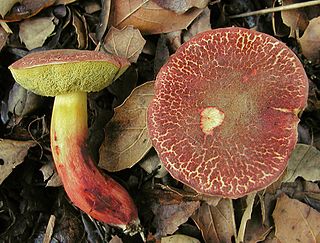
Xerocomellus dryophilus, commonly known as the oak-loving bolete and formerly known as Boletus dryophilus or Xerocomus dryophilus, is a basidiomycete fungus in the family Boletaceae native to North America. It appears to only occur under the coast live oak, and is only found in California, where it is one of the most common boletes in the Los Angeles and San Diego counties.
